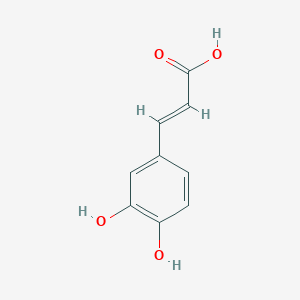Detail Information of Xenobiotics
| General Information of Xenobiotics (ID: XEO01232) | ||||||
|---|---|---|---|---|---|---|
| Xenobiotics Name |
Caffeic acid
|
|||||
| Xenobiotics Type |
Health or Environmental Toxicant(s)
|
|||||
| Classification |
Health Hazard/Toxicant
|
|||||
| Structure |
<iframe style="width: 300px; height: 300px;" frameborder="0" src="https://embed.molview.org/v1/?mode=balls&cid=689043"></iframe>
|
 |
||||
| 3D MOL | 2D MOL | |||||
| PubChem CID | ||||||
| DME(s) Modulated by This Xenobiotics | ||||||
| DME(s) Inhibited by This Xenobiotics | ||||||
| Arachidonate 15-lipoxygenase (ALOX15) | DME Info | Homo sapiens | [1] | |||
| Azoreductase (azoR) | DME Info | Escherichia coli | [2] | |||
| L,D-carboxypeptidase A (ldcA) | DME Info | Escherichia coli | [2] | |||
| Beta-lactamase (blaB) | DME Info | Escherichia coli | [2] | |||
| Chloramphenicolase (chlR) | DME Info | Escherichia coli | [2] | |||
| Glycoside hydrolase (cscA) | DME Info | Escherichia coli | [2] | |||
| NADPH-dependent curcumin reductase (curA) | DME Info | Escherichia coli | [2] | |||
| Unclear metabolic mechanism (DME-unclear) | DME Info | Escherichia coli | [2] | |||
| Glutamate decarboxylase (gadB) | DME Info | Escherichia coli | [2] | |||
| D-Lactate dehydrogenase (ldhA) | DME Info | Escherichia coli | [2] | |||
| D-Lactate dehydrogenase (ldhA) | DME Info | Pseudomonas aeruginosa | [3] | |||
| Monoamine oxidase type A (MAO-A) | DME Info | Homo sapiens | [4] | |||
| Monoamine oxidase type B (MAO-B) | DME Info | Homo sapiens | [4] | |||
| Molybdopterin-dependent enzyme (molD) | DME Info | Escherichia coli | [2] | |||
| Myeloperoxidase (MPO) | DME Info | Homo sapiens | [5] | |||
| Glutamate racemase (MurI) | DME Info | Escherichia coli | [2] | |||
| Arylamine N-acetyltransferase (NAT) | DME Info | Pseudomonas aeruginosa | [3] | |||
| N-ethylmaleimide reductase (nemA) | DME Info | Escherichia coli | [2] | |||
| NADPH-dependent oxidoreductase (nfrA) | DME Info | Staphylococcus aureus | [6] | |||
| Oxygen-insensitive NADPH nitroreductase A (nfsA) | DME Info | Escherichia coli | [2] | |||
| Oxygen-insensitive NADPH nitroreductase B (nfsB) | DME Info | Escherichia coli | [2] | |||
| NADH dehydrogenase (nuoE) | DME Info | Streptomyces griseus | [2] | |||
| Hydroxybenzoate 3-monooxygenase (pobA) | DME Info | Pseudomonas aeruginosa | [3] | |||
| Tyramine oxidase (tynA) | DME Info | Escherichia coli | [2] | |||
| Beta-glucuronidase (uidA) | DME Info | Escherichia coli | [2] | |||
| DME(s) Induced by This Xenobiotics | ||||||
| L-glutamine amidohydrolase (GLS) | DME Info | Homo sapiens | [7] | |||
| Nitric oxide synthase endothelial (NOS3) | DME Info | Homo sapiens | [8] | |||
If you find any error in data or bug in web service, please kindly report it to Dr. Yin and Dr. Li.

